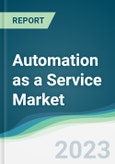The automation as a service market is projected to expand at a CAGR of 21.42% over the forecast period.
This research study examines the automation as a service market based on various segments: component, platform, organization size, end-user and geography. First, a brief overview of the market details key driving factors and challenges. Next, Porter's five forces model analyzes the automation as a service market comprehensively. This is followed by industry value chain analysis which determines the companies which are part of the different processes and contributing to various sectors.The study also presents in-depth information concerning the development, trends, and industry policies and regulations affecting the automation as a service market. Moreover, the research study analyzes the overall regulatory framework of the automation as a service sector, offering stakeholders a better understanding of the key factors influencing the overall market environment.
Automation as a service market - Forecasts from 2023 to 2028 is a comprehensive and latest report. It provides vital market information to executives and interested stakeholders to enable them to get vital market information. The report also analyzes the competitive landscape and details strategies of key market players and also plots them on our vendor matrix in four quadrants: leader, follower, challenger, and niche.
The scope and coverage of the automation as a service market report is as below:
- Automation as a service market data tables and charts
- Market outlook with sections on drivers, restraints, Porter’s and industry value chain analysis
- Market assessment by component into service, and solution.
- Detailed market trends, analysis and graphical representation by platform into on-premise, and cloud-based.
- In-depth analysis of the automation as a service market by organization into small and medium-sized enterprise, and large enterprise.
- Exhaustive coverage of the end-user into retail and consumer goods, manufacturer, healthcare and life sciences, BFSI, telecom and IT, and others.
- A 360° view of the demand for automation as a service market solutions/services across different geographies (North America, South America, Europe, Middle East and Africa, and Asia Pacific) with further breakdown for key countries within those regions.
Different segments covered under the automation as a service market report are as below:
By Component
- Service
- Solution
By Platform
- On-Premise
- Cloud-Based
By Organization Size
- Small and Medium-Sized Enterprise
- Large Enterprise
By End-User
- Retail and Consumer Goods
- Manufacturer
- Healthcare and Life Sciences
- BFSI
- Telecom and IT
- Others
By Geography
- North America
- United States
- Canada
- Mexico
- South America
- Brazil
- Argentina
- Others
- Europe
- United Kingdom
- Germany
- France
- Spain
- Others
- Middle East and Africa
- Saudi Arabia
- UAE
- Israel
- Others
- Asia Pacific
- Japan
- China
- India
- South Korea
- Indonesia
- Thailand
- Others
Table of Contents
1. INTRODUCTION
2. RESEARCH METHODOLOGY
3. EXECUTIVE SUMMARY
4. MARKET DYNAMICS
5. AUTOMATION AS A SERVICE MARKET, BY COMPONENT
6. AUTOMATION AS A SERVICE MARKET, BY PLATFORM
7. AUTOMATION AS A SERVICE MARKET, BY ORGANIZATION SIZE
8. AUTOMATION AS A SERVICE MARKET, BY END-USER
9. AUTOMATION AS A SERVICE MARKET, BY GEOGRAPHY
10. COMPETITIVE ENVIRONMENT AND ANALYSIS
11. COMPANY PROFILES
Companies Mentioned
- Microsoft
- Blue Prism
- HCL Technologies
- IBM
- Automation Anywhere
- Uipath
- Hewlett Packard Enterprise
- Nice Ltd.
- Kofax
- Pegasystems
Methodology

LOADING...








